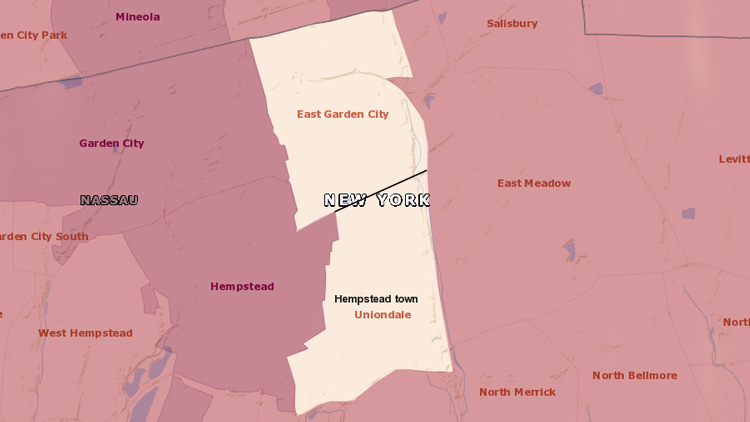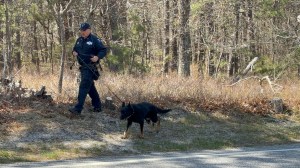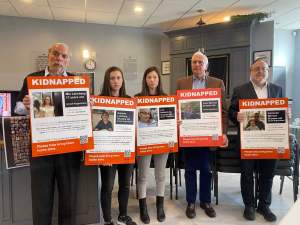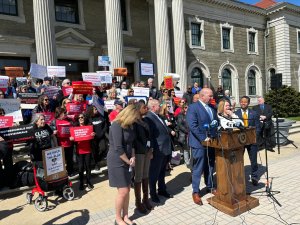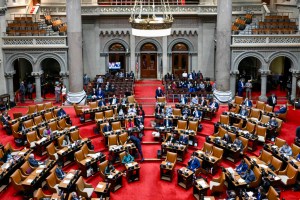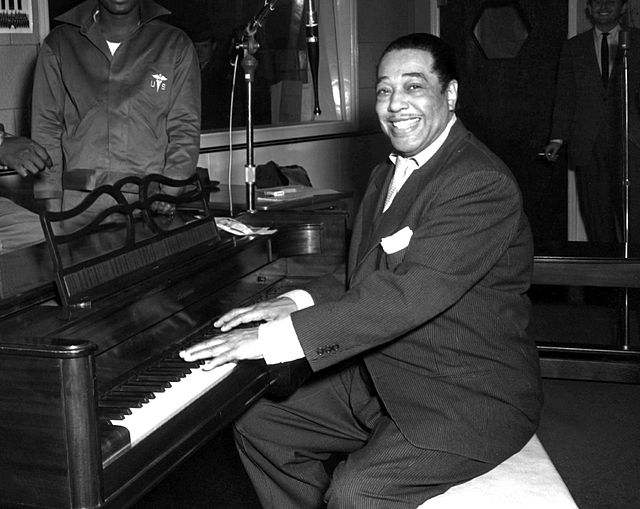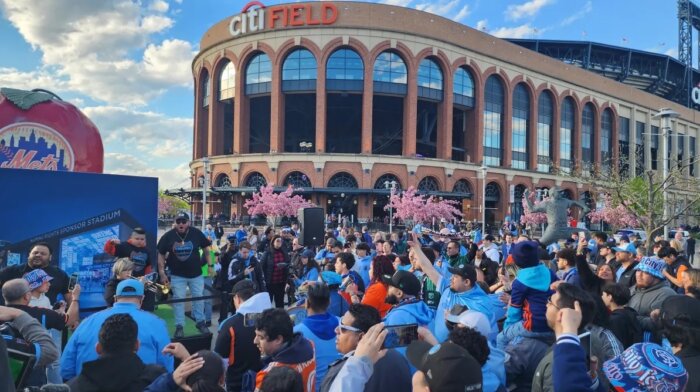Sirens blazing, Uniondale firefighters recently rushed to Hempstead Town Hall, where they joined a protest brigade trying to extinguish their neighboring community of East Garden City, which has sparked fears of gentrification.
Civic leaders from Uniondale say East Garden City doesn’t technically exist. They argue that planners and developers concocted the name to distance prime real estate north of Hempstead Turnpike from the racially diverse neighborhood on the south side. Lawmakers back Uniondale’s cause, but wiping East Garden City off the map is easier said than done. At stake is what to call the heart of the area also known as the Nassau Hub—home to almost half the county’s economic activity and Nassau Veterans Memorial Coliseum.
“It’s a shame! It’s a pity! We don’t want East Garden City!,” chanted dozens of protestors outside town hall during the March 10 rally as a convoy of Uniondale fire trucks rolled up in support—lights flashing and horns blasting.
“Greedy developers are trying to steal the economic assets and commercial tax base of one of the few racially integrated communities on Long Island,” said Gregory Maney, a Hofstra University professor and co-facilitator of the Greater Uniondale Area Action Coalition (GUAAC), to the Hempstead Town Board after the rally. “The East Garden City fiction is a thinly veiled gerrymandering and gentrification initiative to strip a majority minority community of our core assets.”
The area known as East Garden City, as the name suggests, lies east of the well-to-do village of the same name. It’s one of many unincorporated hamlets that cause geographic confusion across LI, but is the only one to spark protests of late. And its origins are the subject of much debate.
Entities that list their address as East Garden City—many of which drop the “East”—include Nassau Community College (NCC) and Museum Row as well as homes and businesses along Stewart Avenue between Merchants Concourse and the western border of Roosevelt Field Mall, which also falls east of village limits. Right across the street from NCC, the coliseum and several major office buildings are listed as Uniondale—yet the arena’s website only identifies its address as “Long Island.” Forrest City Ratner is slated to begin an estimated $260-million renovation of the coliseum this summer.
According to a U.S. Census Bureau map, the northern border of East Garden City is Old Country Road, but businesses and homes between that thoroughfare and Corporate Drive to the south list their addresses as Westbury. Yet that area does not fall within the Westbury village border, either.
For taxing purposes, the 3-square-mile locality known as East Garden City falls within the Uniondale Library District and the Uniondale School District. It has the same zip code as Garden City. But what concerns Uniondale residents most is that East Garden City became its own census designated place (CDP) in the 2000 count—a development that, some worry, could lead to the area being incorporated, and that, they fear, could mean its usurping Uniondale’s biggest tax revenue generators.
“The Uniondale School District relies on the entire tax base of Uniondale, and the possibility that part of that tax base will be taken away has worrisome implications,” said William Lloyd, superintendent of the Uniondale School District, which the state has classified as a high-needs district.
An “East Garden City” sign on Stewart Avenue was removed amid the growing debate. The Uniondale Fire Department has also been installing “Welcome to Uniondale” signs around the disputed area. With such contradictory signage, Uniondale’s suspicions seem justified.
“There is no plan afoot to rename the coliseum area,” Hempstead Town Supervisor Kate Murray told skeptical Uniondale residents when they urged the town board to pass a resolution codifying that East Garden City does not exist. At the town’s April 14 meeting, the board passed a resolution urging the Census Bureau to nix East Garden City. She later said the board plans to delete mentions of East Garden City from all town documents.
“The community of Uniondale has been treated like a hockey puck and we’re tired of it,” said Jeannine Maynard of GUAAC, an umbrella group of civic associations that are leading the charge to abolish East Garden City.
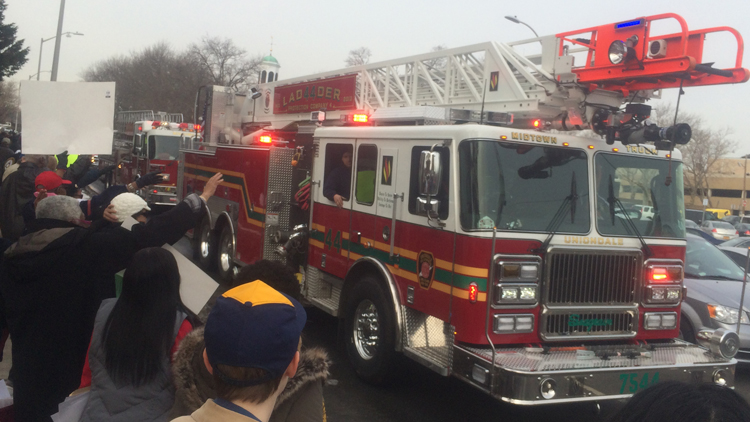
CENSUS-TAKING BLUES
The former Nassau County district attorney who was elected last year to represent the disputed domain in Congress has urged Census officials to remove East Garden City from the 2020 count.
“We do not know how or why it was decided that this area, which has historically been part of the Uniondale community, should become its own census-designated place under a different name,” U.S. Rep. Kathleen Rice (D-Garden City) wrote in a letter to the Census Bureau’s New York Regional Director, Jeff Behler.
Census officials said that East Garden City became a CDP based on information provided by local planning offices and elected officials, adding that the boundary of Uniondale has not changed “since at least 1990.” The agency noted that CDPs are only used for counting populations, so their borders aren’t legally binding.
“To change the boundaries of Uniondale and East Garden City, the Census Bureau would need to receive notification from Nassau County, the partner who originally delineated the geography for this area,” Vince Oiser, chief of the Geographic Standards Criteria Branch, said in a statement. “The Census Bureau will work with local officials to accommodate a change if requested.”
When asked who specifically on the local level the Census worked with, the bureau directed the Press to Robert Brickman in the Nassau County Planning Department. When Brickman was asked to comment, Sean Sallie, a senior planner in the agency, told the Press that the county has no role in the designation, and he doesn’t know who the Census spoke with, but he sympathized with Uniondale’s concerns.
“Whether you dissolve the [East Garden City] CDP into Uniondale, it doesn’t necessarily cause a reapportionment,” he said. “We can understand if you’re living in Uniondale, on top of your mind is what is the impact on the property tax base.”
Sallie noted that if the East Garden City CDP debuted in the 2000 census, it would predate current staffers in his department. It would also predate the new residential developments in East Garden City—Avalon at Garden City, Meadowbrook Pointe and Archstone Meadowbrook Crossing apartments. For such a change to occur in time for the 2000 census, the request would date back to the administration of former Nassau County Executive Thomas Gulotta, the Republican who nearly bankrupted the county.
To address Uniondale’s concerns, Congresswoman Rice met last week with Census officials, civic leaders, Nassau County and Hempstead town officials and others. She announced afterward that Census officials agreed to the request to repeal “East Garden City” as a CDP. The Nassau County Planning Commission said it will follow Hempstead Town’s lead in passing a resolution formally requesting the Census to dissolve the East Garden City CDP.
“We know there’s no such thing as ‘East Garden City,’” Rice said. “It’s Uniondale, and calling it by any other name will only divide a community that should remain whole.”
The hard part now is spreading the word, civic leaders said.
“We’re calling upon media outlets, government agencies, businesses and developers and realtors to consistently use the name Uniondale when referring to” the area known as East Garden City, said GUAAC’s Maynard during a news conference following the meeting with Census officials.
HAZE OVER GARDEN CITY
Uniondale isn’t the only place that’s anti-East Garden City. The Village of Garden City has historically opposed the unincorporated area using a knockoff of its name without homeowners and businesses located there paying village taxes.
The village took their gripe to a different federal agency: The U.S. Postal Service. That’s because when letter carriers started using zip codes in 1963, Garden City didn’t get its own. To this day, it shares its 11530 designation with the Village of Stewart Manor, the unincorporated hamlet of Garden City South and East Garden City, which isn’t an uncommon situation.
“Because ZIP Codes are based on the location of delivery post offices, they often do not correspond to political jurisdiction boundaries,” said Maureen Marion, a spokeswoman for the postal service. “This means millions of Americans receive their mail delivery from post offices that are located in adjacent towns, villages or cities.”
Seventeen years ago, the village had asked the postal service’s ZIP Code Boundary Review committee to consider changing the code to better distinguish Garden City from East Garden City, but the committee denied the request. Applicants can try again once a decade, but the village hasn’t bothered, according to the postal service.
“Garden City is America’s first planned community,” Bertram Donley, then-vice president of the Garden City Chamber of Commerce told Newsday in 1998. “It’s sort of like a brand name, and you have people ripping off that brand name.”
The current leadership of that business group referred a request for comment to the village administration, which did not return calls.
“Is it not absurd that this immense area east of Garden City is paying taxes supporting other places and other schools but still have a Garden City address?!” wrote John Ellis Kordes, the former Garden City village historian, in the Garden City News three years ago.
ZIP code changes are most likely to occur when a community has a growth spurt, but the community identity argument is often dismissed, said Marion, the postal service spokeswoman.
“It’s not necessarily the easiest thing,” she said.
And so, the post office at Roosevelt Field Mall—which used a Mineola address when it was an air field, notes North Hempstead Town Historian Howard Kroplick—remains billed as Garden City, despite its location just east of the village line. Garden City Bowl and Avalon Bay remain open for business and rentals. And a “Welcome to Uniondale” sign sits at the corner of Quentin Roosevelt Boulevard and Commercial Avenue—50 feet from an office building called the Garden City Center.
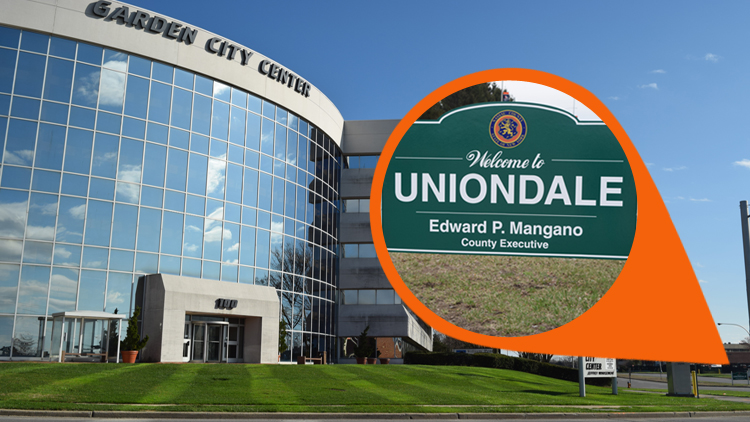
BLURRED LINES
Studies terming LI among the most racially segregated suburbs nationwide often cite the line dividing neighboring villages of Hempstead and Garden City—the former black and working-class, the latter wealthy and white.
Evidence of this division has been proven in court. In December 2013, a federal judge ruled that Garden City village officials violated the federal Fair Housing Act by approving a zoning ordinance that nixed a planned affordable housing complex, effectively discriminating against would-be minority residents. Garden City’s appeal of the decision is pending.
“In Garden City, like too many other cities in New York, working families of color are unfairly excluded from finding a safe and affordable place to live,” said Ismene Speliotis, executive director of the nonprofit Mutual Housing Association of New York, at the time. “It’s sad that, in Garden City, it’s taken a years-long legal battle to force them to stop.”
Hempstead’s border with Garden City is a more stark black-and-white separation, but Uniondale’s border with East Garden City is blurrier, since both areas are unincorporated hamlets. Of the more than 6,200 residents in East Garden City, 67 percent are white while nearly 90 percent of Uniondale’s nearly 25,000 residents are minorities, according to the Long Island Index, a non-profit research group funded by the Rauch Foundation.
Hempstead and Uniondale share a border as well, and together with Roosevelt and Freeport, they form a “Corridor of Color” though south-central Nassau, as community leaders have come to describe it. Hempstead-based civil rights attorney Frederick Brewington, a co-convener of The Corridor Counts, an advocacy group that represents the area, notes that the fact that Uniondale is unincorporated made it easy to surreptitiously rename about half the community.
“Simply because Uniondale doesn’t have its own government, a village government, people thought that they were easy pickings,” Brewington says.
PROMISED LAND
The issue of what to call the area where East Garden City and Uniondale intersect dates to at least 1961, when the Mitchel Air Force Base was decommissioned and the county subdivided the parcel into NCC, Hofstra University, the Nassau Coliseum and nearby office complexes.
When NCC acquired its campus in 1962, it used a Garden City address, but when the coliseum opened across the street a decade later in ’72, the arena was listed as being in Uniondale. The southwest corner of the former military base went to Hofstra University, which lists its address as Hempstead, since the college was founded within its village boundaries.
Interestingly, Hofstra noted on its website that parts of the campus fall within Hempstead, Uniondale and East Garden City. When asked to clarify the geography, Karla Schuster, a Hofstra spokeswoman, said the website was wrong. The area south of Front Street and west of California Avenue are Hempstead and “everything else on campus is in Uniondale,” Schuster said.
During the March rally at Hempstead Town Hall, some longtime residents told the board that the boundaries of Uniondale extend as far north as Old Country Road, adjoining Westbury village’s southern border.
“It’s just unbelievable that the town could be cut in half the way it has,” said Marie Catanese, an 89-year-old Uniondale resident who has lived in the community since 1955 and been defending its border since the 1970s as co-founding president of Uniondale Neighbors In Total Effort (UNITE).
Kordes, a former Garden City village historian, has a different assessment about what to call East Garden City—and how far back the debate goes. He suggests that it originated in 1869, when wealthy entrepreneur Alexander Stewart bought 4,000 acres of the Hempstead Plains for $400,000 and founded Garden City village there that year.
“Uniondale predates Garden City as a settlement, however, you can’t call [East Garden City] Uniondale because it was part of the original Stewart purchase of the Hempstead Plains and never part of Uniondale (although it is within the Uniondale School District),” he wrote. “You could rename the area Meadow Brook, N.Y., as that is an historically correct name for that area but renaming it would be difficult at this time.”
A historian on the Uniondale side of the debate suggests that Uniondale’s claim to the East Garden City area predates even the Stewart purchase.
“The oldest of the Uniondale boundary lines are those established back in 1813 which make up the Uniondale School District,” William Rowe wrote in The Uniondale Story, published in 1963. “The school district lines go as far north as Old Country Road.”
But he also conceded that the Uniondale lines are open to interpretation.
“As an unincorporated area…Uniondale has no exact boundary lines except for those which are set up for specific purposes,” he wrote, citing the school district and fire district borders as examples.
COLISEUM TOWN
Uniondale activists publicly launched their fight just as the county and town started finalizing plans to renovate Nassau Coliseum, which falls within the East Garden City CDP but has a Uniondale address.
When Nassau County lawmakers and Hempstead town council members voted on measures advancing the plans in recent weeks, the advocates showed up in force to urge Forrest City Ratner, the coliseum’s incoming operator, to invest in Uniondale. The change in the arena’s operators comes as its anchor tenant, the New York Islanders, moves to the Barclays Center in Brooklyn following years of stalled plans to renovate the facility at the Hub.
“We are demanding economic justice and corporate responsibility,” Pearl Jacobs, co-chair of the Nostrand Gardens Civic Association, told Nassau legislators in April. “As the host community, Uniondale will bear the brunt…of redevelopment. Uniondale and its adjacent communities should receive a community benefit agreement [CBA] to offset the inconvenience.”
Advocates argued that since Forest City Ratner signed a CBA with Brooklyn when it built the Barclays Center, Uniondale should get the same treatment when the developer renovates the coliseum. Ashley Cotton, a spokeswoman for the developer, countered that it’s not a fair comparison.
“It is an entirely different scope in terms of scale and substance,” she said of the 28-acre, $4-billion Barclays project, which had a residential component. She noted that the company has committed to hire locally and offer discounted tickets to local groups once the renovated coliseum reopens.
Minority Leader Kevan Abrahams (D-Freeport), who represents Uniondale, pushed for more, including investments in the community center, cleaning up vacant homes and providing other upgrades.
“Whatever you want to call it, this community is absent an agreement that offers them something in exchange for being the host community for the coliseum,” he said.
And if all goes as planned, Uniondale will play host to a lot more than just the coliseum. After County Executive Ed Mangano announced during his state of the county address that two new Sloan Kettering Cancer Institute facilities are planned for the coliseum site, GUAAC launched a letter-writing campaign to ensure that the new medical center calls its planned location Uniondale and not East Garden City.
But, regardless of what it’s called, those tasked with protecting the disputed area are going to continue responding to 911 calls for help no matter whether those on the other end of the line believe they’re in Uniondale or in East Garden City.
“Our trucks say Uniondale, and the men and women in our department risk their lives every day for the Uniondale community,” said Uniondale Fire Commissioner Richard Harris. “It’s troubling to me that part of our community has been taken away from us.”



